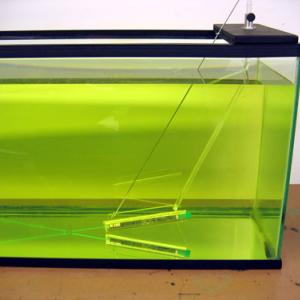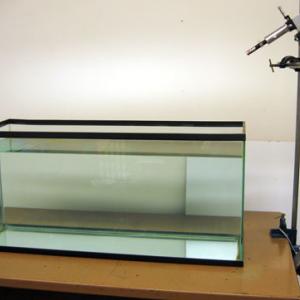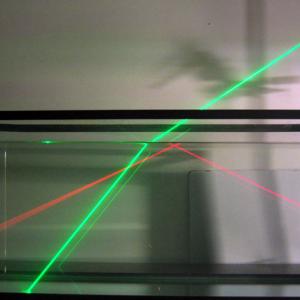College of Liberal Arts & Sciences
6A44.20 - Critical Angle - Laser and Tank
Video Credit: Jonathan M. Sullivan-Wood
The tank and a laser can be used to show critical angles and total internal reflection. You can stop the total internal reflection by disturbing the surface of the water where the laser beam strikes it.
CAUTION: These are high power lasers. Extreme care must be taken to insure that they are NEVER pointed at the audience, or more likely, impact the eyes of the lecturer.
The usual solution for the fish tank is to put 2 tablespoons of "Pine-Sol" into the 40 gallons of water that the tank holds. 1/4 bottle of the green fluorescent dye can also be added to enhance the laser beam viewing. This solution will work with both green and red lasers.
NOTE: The Pine-Sol will degrade the seals of the fish tank if left in for extended periods of time (months). Fill the tank just before it will be used in the semester curriculum and empty when the semester is done.
A solution that will work only for red lasers is to put 3 to 4 teaspoons of water soluble Fluorescein into the 40 gallons of water the tank holds.
The above (Fluorescein) solution will only need to be emptied from the tank if the water become dirty of collects too much chalk. Otherwise, it will remain good for this demonstration for up to a decade.
Tape playing cards to the sides and bottom of the 1 foot square Plexiglas tank. Fill the tank with water and note how the index of refraction and critical angle seems to make some cards disappear unless looking straight through the tank at the side they are taped to. You can also make one of the cards visible no matter where it is taped if you put some Vaseline between the card and the side of the tank, thus elliminating the air layer between the card and tank.
The round flask model shows why people who have some eye surgeries in which an air bubble is inserted have trouble seeing when looking down due to a total internal reflection effect.
- Santiago Velasco and Alejandro del Mazo, "Visualization of Four Optics Phenomena in a Single Experiment", TPT, Vol. 57, #6, Sept. 2019, p. 430.
- Dianna Samuelson Dibble, Kaitlin (Katie) Van Alstyne, Jim Rohr, Sam Ridgway, "The Dolphin in the Mirror - A Familiar Face", TPT, Vol. 55, #1, Jan. 2017, p. 8.
- Philip DiLavore, "Reflection and Refraction at an Interface", TPT, Vol.13, #4, Apr. 1975, p. 247.
- "O-305. Water Tank & Scattering Medium", DICK and RAE Physics Demo Notebook.
- Freier and Anderson, "Oe-1", A Demonstration Handbook for Physics.
- Borislaw Bilash II and David Maiullo, "Optical Card Tricks", A Demo a Day: A Year of Physics Demonstrations, p. 343.
- Borislaw Bilash II and David Maiullo, "It's Critical", A Demo a Day: A Year of Physics Demonstrations, p. 341.
- "Critical Angle", Exploratorium Science Snackbook, p. 33.1 - 33.2.
- "Critical Angle", The Magic Word and Other Experiments in Light & Color by The Exploratorium, p. 29 - 34.
- Robert Ehrlich, "Total Internal Reflection at a Two-Liquid Interface", Turning the World Inside Out, p. 180 - 181.
- Brian Jones, "Optical Card Tricks", Little Shop of Physics, Colorado State University, Fort Colliins, CO.
- Tik L. Liem, "Use Water As A Mirror", Invitations to Science Inquiry - Supplement to 1st and 2nd Ed. p. 92.
- Julius Sumner Miller, Q178 & A178, Millergrams II – Some More Enchanting Questions for Enquiring Minds, p. 46 & 100.
- Joseph Frick, "#164 - Total Reflection", Physical Technics: Or, Practical Instructions for Making Experiments in Physics and the Construction of Physical Apparatus with the Most Limited Means", p. 191.
Disclaimer: These demonstrations are provided only for illustrative use by persons affiliated with The University of Iowa and only under the direction of a trained instructor or physicist. The University of Iowa is not responsible for demonstrations performed by those using their own equipment or who choose to use this reference material for their own purpose. The demonstrations included here are within the public domain and can be found in materials contained in libraries, bookstores, and through electronic sources. Performing all or any portion of any of these demonstrations, with or without revisions not depicted here entails inherent risks. These risks include, without limitation, bodily injury (and possibly death), including risks to health that may be temporary or permanent and that may exacerbate a pre-existing medical condition; and property loss or damage. Anyone performing any part of these demonstrations, even with revisions, knowingly and voluntarily assumes all risks associated with them.



